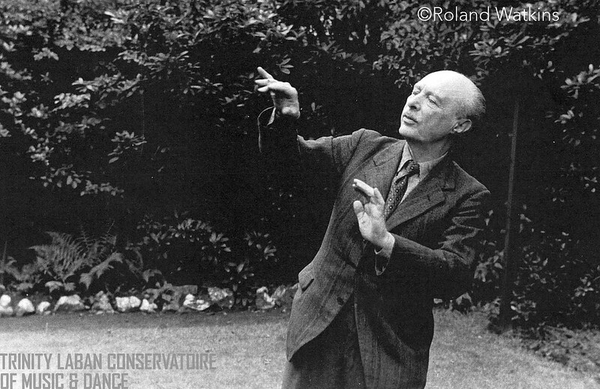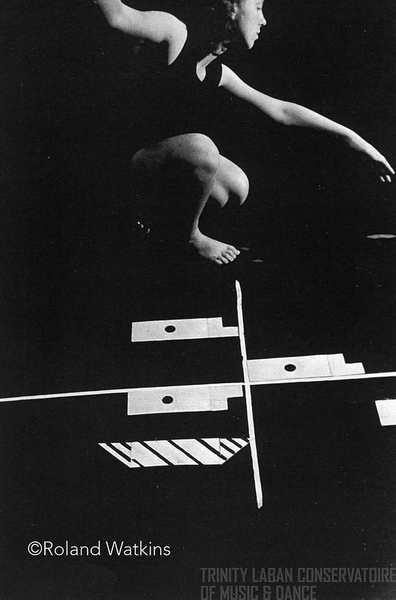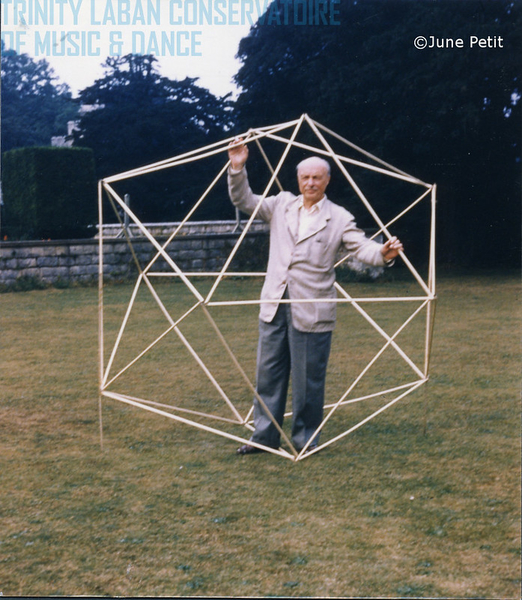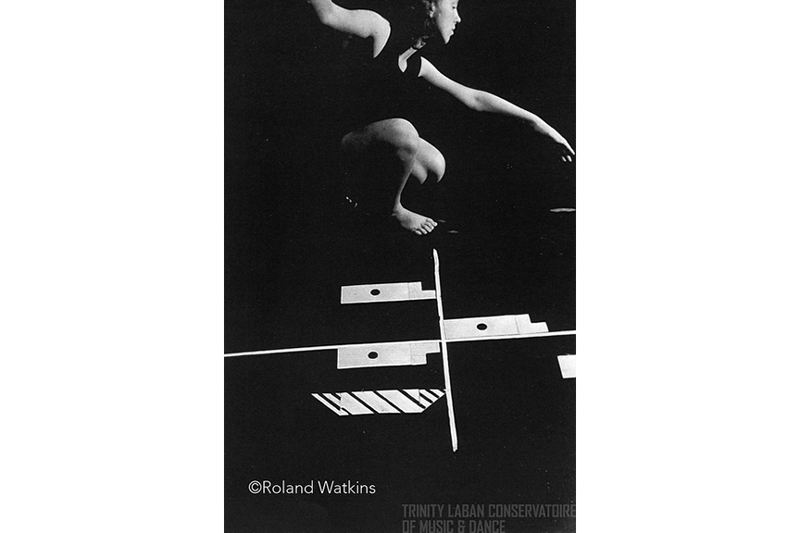
A system that separates movement into its component parts for examination, can help observers interpret what we see more clearly and help movers express what we intend more accurately.
Elliot Eisner, former professor of Art and Education at the Stanford Graduate School of Education, said: “By trying to describe what we see, we gain insight. By trying to articulate what is before us, we actually discover what is there.”
Rudolf Laban did just that almost 100 years ago in Europe. He believed that dance as an art form wasn’t as respected as theater, music and visual art, and because it disappears as soon as it is created, dance couldn’t be studied by scholars and critics. It had no script like a play, no score like music, no painting or sculpture like visual art.
So Laban set out to find a way to write dance down. In order to do that, he had to figure out “What is Movement Made Of?” One result of his research was Labanotation – the detailed scoring of dance with symbols on a staff for the purpose of study and reconstruction. This is the WHAT of movement – it tells you what happened. Almost 1000 dances have been notated and reconstructed using Labanotation.
But another result of his research was the HOW or qualitative aspects of movement, which is what we’ll explore today. It’s called Laban Movement Analysis (LMA).
Laban’s system acts like a prism that separates light into a spectrum of colors. Using it, we can see each color separately, knowing that in reality they exist simultaneously.
Because movement is a language, a way we communicate, Laban’s prism makes possible a vocabulary and a semantics of movement that creates order out of seeming chaos.
One of the strengths and beauties of Laban’s movement analysis, is that like a language it changes over time. It is continuously being added to, modified, and adapted to diverse disciplines by his colleagues, students and new practitioners.
Today it is applied and customized to dance (performance, choreography, pedagogy), theater (character development, directing), movement for musicians, athletic coaching, somatics, computer animation, robotics, child development, early education, psychology, anthropology, physical therapy, dance therapy, bullying prevention, conflict resolution, public speaking, business management, leadership training and many more fields, anywhere movement is important functionally or expressively.
The current field of LMA rests upon Laban’s original research and humanistic values. One value which underlies all of his theories will be an important part of our exploration today:
When the mind, body and emotions are all in play, a whole healthy person emerges.
A few facts to put Laban in context:
1. Born in 1879 in Austro-Hungary, he died in England, in 1958. In between he studied art, music, architecture, mathematics, taught dance and theater, founded schools, choreographed, wrote and researched. He was part of the cultural and artistic revolution of the early 20th century, especially in Paris and Munich. He knew personally or knew the work of his contemporaries: Stravinsky and Debussy, Joyce and Pound, Freud and Jung, Kandinsky and Picasso; his students included Mary Wigman, Kurt Jooss and Jan Veen, who founded the Boston Conservatory Dance Department in 1948. Laban’s artistic descendants include Hanya Holm, Alwin Nikolais, Pina Bausch, and William Forsythe.
2. One of Laban’s lifelong goals was to find the elements that all movement have in common: from conversational gestures to martial arts, from brushing one’s teeth to playing the trombone, from folk dance to ballet to hip hop, including all cultures, nationalities, ethnicities, gender identities and ages.
3. Laban identified 5 main elements of ALL movement, with a few categories under each. You might ask how such a simple organization can describe the infinite variety of human movement. How is it possible that all of English literature is written with only 26 letters and a few punctuation marks? How can all of Western classical music be composed with only 12 tones and a few expression symbols? The answer is that the inclusion, exclusion, combination, sequencing and frequency of a few elements create the myriad possibilities.
Let’s explore the elements…
Every time we move a few things CHANGE.
Change your position. Make a small change of position. Make a big change of position.
The specifics don’t matter.
Every time we move, 5 things happen:
THE BODY FORMS ITSELF IN SPACE WITH ENERGY in RELATION TO OTHERS
BODY: the physical body (muscles, bones, organs, etc. – our material self) is animated – it STIRS.
FORM (SHAPE): the body parts REORGANIZE IN RELATION TO EACH OTHER.
SPACE: the body TAKES UP SPACE DIFFERENTLY, TRANSFORMING THE SPACE IT OCCUPIES.
RELATIONSHIP: the body’s connection to other people, if they are around, is ADJUSTED.
ENERGY: is employed to make those changes. If the body is the car, ENERGY IS THE ENGINE.
Let’s start with exploring RELATIONSHIP, most obvious and familiar in our everyday lives.
Notice your relationship to others in the room – are you near someone, far from someone, facing the same direction as anyone, making eye contact, touching? Behind or in front of another person?
Change your relationship to others in the room. How is it different now?
Change again. What changed this time?
ACTIONS OF RELATIONSHIP (Music: The Mozart Sessions – Adagio)
Now stay in contact, but look at someone else. How did that change your relationship?
Face your partner, lightly touching fingertips, move together as in a mirror, with no particular leader. Move as equals, together as one. How does this feel?
Release your touch and keeping eye contact, one of you rise higher than the other. One sink lower. Change roles. What resonates from being above and below? Does it remind you of any experience you’ve had, or observed?
One of you make a gesture, the other copy it. Repeat with different gestures, same leader. Change roles. Call and response. Do you prefer to be the leader or follower?
One of you lean into your partner and be supported, the other support your partner’s weight, change roles. What feelings or memories come up for you in each role?
Go far away from your partner, create a lot of distance between you. See each other across the space. Wave to each other as if in a mirror. Distant, but connected.
Everyone in the room, do the same wave in the same rhythm as indicate a person. A community in synchrony. Be still.
Relationship Elements: FORMATION, PROXIMITY, EYE CONTACT, TOUCH, SUPPORT, SYNCHRONY, LEAD/FOLLOW, CALL /RESPONSE
Dynamic, tone, texture, mood – closely related to feelings
SHAKE HEAD NO 2 different ways: vehemently disapprove of me, ashamed of me (tsk,tsk)
WAVE HAND 2 different ways: excited meeting, sad departing
Illustrate differences in Control, Force, Pacing, and Attention to Space around you
Let’s all try some other ways these efforts are used in our life
CONTROL (flow: bound/free) – Does a movement progress with restraint or ease? (thread a needle, throw confetti)
FORCE (weight: strong/light) – Is the pressure firm or gentle? (hammer a nail, stroke a baby’s head)
PACING (time: quick/sustained)) – Is the passage of time experienced with urgency or leisure? (touch a hot stove, savor a delicious food)
ATTENTION TO SURROUNDINGS (space: direct/indirect) – Do we focus expansively or narrowly? (take in a panoramic view of mountains, follow the flight of a bird)
Let’s combine them in various ways
WALK with strength and determination, keep those qualities, but take your time, there’s no rush; become light, gentle and quiet, now move with urgency, too; focus on a particular place or object in the room and go there directly seeing nothing else, focus on a different object or place in the room and go there directly, but reluctantly; now walk with ease and relaxation and freedom, and be aware of everything around you, like a walk in the park on the first day of Spring. Take in the whole room and all the people. Be still.
Let’s focus on a few of these more deeply and explore how mind, body and emotions can come into play simultaneously. Also, notice how personality and mood are connected to energy.
We’ll explore a range of the same energy factor while walking. Follow my verbal cues and allow the cues to affect the way you’re walking. At the end, be still with eyes closed and we’ll do a body/emotion scan, noticing our preferences, familiarities, discomforts, etc.
Optional: same phrase with opposite space efforts••
Energy Elements: CONTROL (flow), FORCE (weight), PACING (time), FOCUS OR ATTENTION (Space)
How are the parts of the body related to each other?
How do we coordinate the body center with the extremities, head to tail, upper body to lower body, one side to the other?
What part of the body is supporting the rest, what actions can the body do?
Actions of the body: (Music: Fila Brazillia, a Zed and 2 L’s)
- move to the music in any way you feel, pause, move again, pause
- flex and stretch your muscles, let your bones move you – bend, extend, rotate your joints
- let your skin move you, change the relationship of your internal organs
- isolate your hand – how many ways can it move keeping rest of body still?
- add other hand, then feet, then head; just move the center of your body, bring extremities close to the center of your body, far away from the center of your body
- put one hand on head, other on tail, how many ways can they change their relationship?
- move your upper body and hold lower body still, move lower body and hold upper body still, move only one side of the body, hold other side still
- move with side to side symmetry/asymmetry, cross one side over the other
- start movement in one body part and have it travel through to another part
- make one large gesture with the whole body, every part moving simultaneously
- shift the weight from one foot to the other (in how many directions can you move?)
- turn around yourself (in how many variations?)
- balance on one foot, lean, fall and catch (several times and variations)
- support yourself with one foot and another body part, support with 3 body parts, can you locomote this way? support with any body part(s) but no feet
- return to 2 feet and have a moment of no floor support (go into the air)
Body Elements: RELATIONSHIP OF BODY PARTS, CONNECTION versus ISOLATION, BASE OF SUPPORT, ACTIONS
PERSONAL SPACE: Kinesphere – the amount of space your body takes up without taking a step
- Find the edge of your Kinesphere and explore it with different body parts.
- Take up a smaller than usual amount of space and keeping that size, move to a different place in the room –Who or what do you feel like? What images emerge? Take up a larger than usual amount of space and move to a different spot – What or whom does this remind you of?
- Reach space: We use different areas of our Kinesphere for different actions. Sometimes we gesture close to our center, sometimes far away.
All try in movement:
Near reach – sewing, rocking a baby, brushing teeth – what else?
Medium reach – Ping-pong, dealing cards – what else?
Far – reaching a high shelf, swimming, tennis – which other sports?
All try my functional gesture phrase:
Reach for the salt across table, shake the salt onto your food, pass the salt
At the gym – wrist curls, rowing machine, jumping jacks
Make your own phrase using one of each reach space. Observe each other. - We use different pathways in our Kinesphere:
Demonstrate and all experience dimensions, planes, and diagonals
DISCO DANCE- Face each other in lines (Music: 2 Locos in a Room – Macarena)
All learn and perform my simple dance consisting of a dimension, a plane and a diagonal. ***
***see Appendix C for specifics
Notice how EFFORT, BODY AND RELATIONSHIP, REACH SPACE and PATHWAYS came into play.
Personal Space Elements:
SIZE OF KINESPHERE, REACH SPACE, DIMENSIONS, PLANES, DIAGONALS
GENERAL SPACE – the environment you are in
• Stand someplace in this room where you feel comfortable. Notice your relationship to the walls, doors, floor, ceiling, objects. Why do you think this place feels comfortable to you?
• Go somewhere in the room you would normally avoid or ignore. What’s different about this place?
• Consider where you choose to sit on an empty bus or train. Window, aisle, middle, near the driver? Space is not an empty void. SPACE is EMOTIONAL!
• Change the direction you are facing. Take in the new perspective. Change again.
• Claim the center of the room as your own, be in orbit around the center.
• Travel in a straight path until you can’t go any further, change direction, keep moving on a straight path, travel in a winding curving path, (how do you usually navigate the world? walk the straight and narrow, literally and figuratively, or snake your way around obstacles?)
• Move along the edge of the room (live on the edge), Stand in a corner (be cornered).
• Get close to the floor, move along the floor, move sideways and backward along the floor (experience feeling lowdown). Come closer to the ceiling (Rise to the occasion).
General Space Elements: LOCATION, DIRECTION, PATHWAY, LEVEL, FACING
How does the body’s form change when relating to the space inside ourselves (inner impulses) and the realities of the space outside of us (external needs)?
1. Lie down as if sleeping, aware of breath making body grow/shrink, every cell, too.
- Expand/contract: Internal motivation, wake up and stretch (also feel full, feel empty)
- Open/reach toward something, then close/retreat from something, External motivation; both symmetrical and asymmetrical
2. Stand up. Let’s play with ways the body changes shape in acting upon and reacting to the environment. Use various body parts and directions in space.
- Pierce space like a spoke or arrow (linear, 1 dimensional)
- Slice space like a scythe making arcs (planal, 2 dimensional)
- Carve the space, enclose or gather space all around you, spread or scatter space away from you (spiraling, 3 dimensional)
- Be an artist making an enormous sculpture, using your hands and whole body as your sculpting tool. Work with a partner: one be a sculptor, the other a sculpture
3. Shape concepts relate to the progression in human development, infant becoming a mature adult: self, I want or reject, connect one thing to another, negotiate, accommodate
Shape Elements: GROW/SHRINK OR OPEN /CLOSE, 1 2 and 3 dimensional (spoking, arcing, carving)
Everyone in a circle, holding hands: walk in and stamp feet, walk out and stamp feet, walk in and flick hands high, walk out and tap chest gently, slow turn around self, twirling imaginary handkerchief, quick turn opposite way, touch floor, knees, shoulders with opposite hand, touch person to your right, touch person to your left. Repeat.
Light
You are a gentle person, who likes to use a soft delicate touch.
You tread lightly on the earth.
You don’t use much pressure physically or in relationships – you don’t want to offend or hurt anyone.
And you are sensitive to being pressured – it makes you uncomfortable.
You are a person who floats through life.
It’s hard to keep your feet planted firmly on the ground.
People may describe you as wispy.
They don’t know where you stand because you never take a stand.
You are afraid to make things happen because then you would be responsible for the outcome.
Strong
Today you feel grounded, self-assured, solid, confident of your place in the world.
You believe you can make a difference in the world, effect change, make an impact.
You know how to be firm, even forceful when necessary.
You are not afraid to pressure people to get what you want.
You have been known to throw your weight around and treat people roughly at times.
People have called you pushy, aggressive.
Bound
You are a composed person.
You move with care, clarity and precision.
You try not to make mistakes or hurt other people, so you move with restraint and containment.
You are cautious about sharing your feelings, and can withhold them when necessary.
People trust you with their secrets.
You like to have things under your control. You don’t like surprises.
You go out of your way to avoid surprises, controlling as much as possible.
You are rigid and uncompromising.
Free
You are a relaxed person with a carefree attitude.
You are easy going, you “go with the flow”, a free spirit.
Some people call you careless, but you don’t care.
Whatever you do, you do it wholeheartedly, with abandon and without restraint.
Once you begin something, there’s no stopping you.
But you can be overly enthusiastic, unable to contain your energy,
Even when it interferes with others and sabotages your efforts.
Sometimes you are even reckless and out of control.
Gather phrase with space and time efforts, using motif writing and effort symbols
| Beckon with hand and arm to the corner, take your time (hurriedly) | Hands and arm shoot up overhead urgently (no rush) | Hands lower into prayer position leisurely (quickly) | Arms gather side space and bring it behind with speed (lazily) |
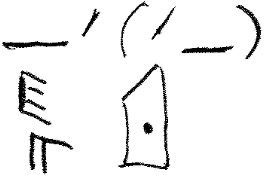 |
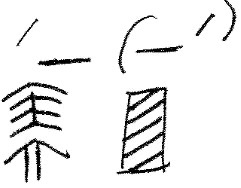 |
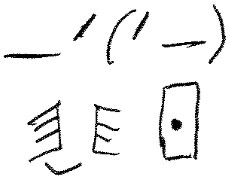 |
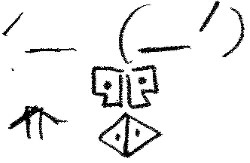 |
| Jab finger 3X to cue in 3 different instruments | Open hands and sound expansively like air filling a balloon | Sh-h-h, fingers to mouth, pianissimo | Shake hands rising with power and control (palms up) | Suppress sound by lowering hands (palms down) |
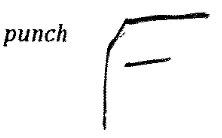 |
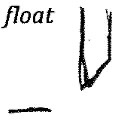 |
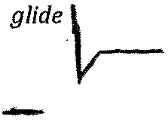 |
 |
 |
Disco Dance
| Push r l r l hand forward toward partner (palms forward) | Hands wave overhead (palms forward) | Point with finger to diagonals | Hips and hands (palms down) circle, turn around self |
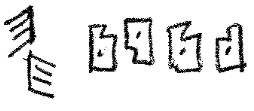 |
 |
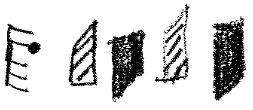 |
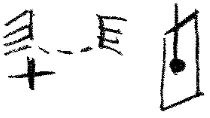 |
Display on white board:
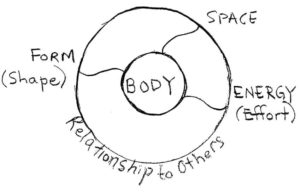
Underlying value:
THOUGHT + MOTION + EMOTION = A WHOLE HEALTHY PERSON
Image from:
A VISION OF DYNAMIC SPACE by Rudolph Laban, compiled by Lisa Ullmann, Laban Archives in association with The Falmer Press, London & Philadelphia, 1984
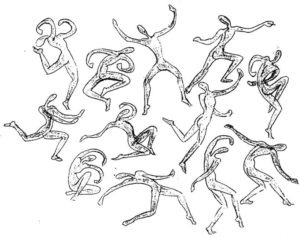
Photographer: Roland Watkins. Held in the Laban Collection, Laban Library and Archive, Trinity Laban Conservatoire of Music and Dance.
RefNo: LC/A/14/1/63
http://calm.trinitylaban.ac.uk/CalmView/Record.aspx?src=CalmView.Catalog&id=LC/A/14/1/63

